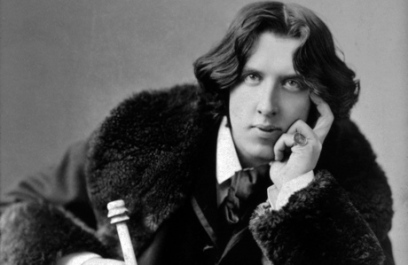 Oscar Wilde is arguably one of the most famous and lasting playwrights since William Shakespeare — and his work was popular to boot. He was a celebrity in his time, known even then for being an extremely quotable master of one-liners.
Oscar Wilde is arguably one of the most famous and lasting playwrights since William Shakespeare — and his work was popular to boot. He was a celebrity in his time, known even then for being an extremely quotable master of one-liners.
He was born on October 16, 1854 in Dublin, Ireland. His parents, Sir William and Jane Wilde, gave him the most Irish name they could: Oscar Fingal O’Flahertie Wills Wilde. Just try yelling out that entire thing when you’re mad at your kid. That’s a chore. Anyways, he was the second child of three — his older brother Willie and younger sister Isola. His parents were part of Dublin’s intellectual elite — Sir William was a doctor notable for taking care of the city’s poor and who had also written and published numerous works regarding medicine, archaeology and folklore while Jane was an Irish nationalist publishing revolutionary poetry for the Young Islanders under the pen name Speranza. They instilled a love of poetry and folklore in all of their children.
Until age of nine, Wilde was educated at home by his mother, a French nursemaid, and a German governess. As such, he became fluent in French and German very early. Then he was enrolled at the Portora Royal School — a free school. While he was there, Isola Wilde died of meningitis in 1867.
Wilde graduated from the Portora Royal School in 1871 and began attending Trinity College in Dublin. There he studied classic literature and Greek alongside his older brother Willie and joined the University Philosophical Society. Through this society, he became an enthusiastic member of the Aesthetic Movement — an intellectual movement prioritizing the appreciation of beauty over social and political themes in literature, fine art, music, and other arts.
While at Trinity, he also befriended Edward Carson — a name you’re going to want to remember for later. They stayed very close friends throughout their college years, but drifted apart in adulthood. Wilde proved to be a gifted student — coming in at the top of his class in his first year of studies and eventually winning Trinity College’s highest academic award, the Berkeley Gold Medal. In 1874, having out-nerded everyone in Ireland (and with encouragement from his teachers who were probably tired of being shown up by him), he applied for and obviously received a scholarship to Magdalen College in Oxford.
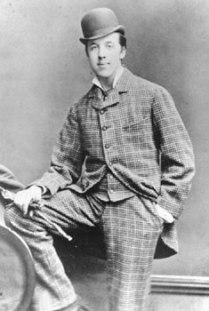 At Magdalen College, Wilde reinvented himself. He explored several organizations, religions and philosophies. He toyed with joining Roman Catholicism — despite threats that his father would cut him off financially if he was baptized into that faith. Wilde ultimately decided, at the last minute, not to do it, and sent flowers to the ceremony in his place. He said he liked their aesthetic, rather than their beliefs. Wilde also replaced his Irish accent with an upper class British accent, began to dress in formal wear literally all of the time and lavishly decorated his room with peacock feathers. It was about this time — no surprise — that he became involved in the Decadent Movement.
At Magdalen College, Wilde reinvented himself. He explored several organizations, religions and philosophies. He toyed with joining Roman Catholicism — despite threats that his father would cut him off financially if he was baptized into that faith. Wilde ultimately decided, at the last minute, not to do it, and sent flowers to the ceremony in his place. He said he liked their aesthetic, rather than their beliefs. Wilde also replaced his Irish accent with an upper class British accent, began to dress in formal wear literally all of the time and lavishly decorated his room with peacock feathers. It was about this time — no surprise — that he became involved in the Decadent Movement.
As anyone who’s ever been to school knows, standing out isn’t always a popular thing. People attempted to beat up or bully Wilde on more than one occasion — but Wilde was 6’3″ and really strong — especially for someone who pretty much hated sports. He once beat up an entire group of students who attacked him, then invited onlookers to go to the room of one of his assailants where they drank all that student’s liquor. He did, at some point (before or after this, I’m unclear), take up boxing — probably not so much as a sport but as a means of self-defense.
The lifestyle he’d adopted was not conducive to studying, and Wilde did not remain the star pupil he had been at Trinity. After returning late from a trip to Greece with a professor, Wilde was even temporarily expelled. Despite this, when he graduated in November of 1878, he received double first (the highest possible honor) for his Bachelor degree in Classical Moderations and Literae Humaniores (basically, literature, just made to sound fancier.) In the same year his poem “Ravenna” won the Newdigate Prize, a high honor for students at Oxford.
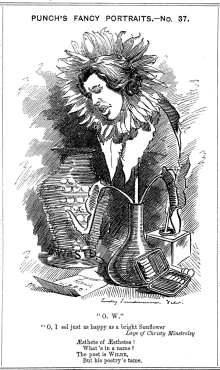 Wilde settled in London after graduating, though he spent a good amount of time in Paris. In 1881, a collection of his poems (now having been published in various places since roughly 1871) was published. The first print run of Poems was 750 copies — it sold out and had to have a second run printed in 1882. Despite the book’s undeniable popularity, reviews were mixed — the British magazine Punch was notably unenthusiastic. Their review stated: “The poet is Wilde, but his poetry’s tame.” (Don’t you sometimes wonder if people write intentionally bad reviews just so they throw in some solid gold zingers like that one?)
Wilde settled in London after graduating, though he spent a good amount of time in Paris. In 1881, a collection of his poems (now having been published in various places since roughly 1871) was published. The first print run of Poems was 750 copies — it sold out and had to have a second run printed in 1882. Despite the book’s undeniable popularity, reviews were mixed — the British magazine Punch was notably unenthusiastic. Their review stated: “The poet is Wilde, but his poetry’s tame.” (Don’t you sometimes wonder if people write intentionally bad reviews just so they throw in some solid gold zingers like that one?)
Because the aesthetic movement was becoming popular in the United States thanks to Gilbert & Sullivan’s Patience (which features a character satirizing Wilde), talent agent Richard D’Oyly Carte booked Wilde for a lecture tour in America coinciding with the tour of Patience. The press in the United States was even more critical of Wilde than it was in Britain. T.W. Higginson wrote that Wilde’s “only distinction is that he has written a thin volume of very mediocre verse” and expressed concerns about the influence Wilde might have on people’s behavior.
Wilde was also subjected to some incredibly bigoted anti-Irish attacks in the press — on January 22, 1882 (just twenty days after he landed in the country!) the Washington Post published a drawing of Wilde next to the Wild Man of Borneo (one of P.T. Barnum’s “freak show” performers) and asked “How far is it from this to this?” Despite the press, Wilde’s actual lectures were very popular and his tour was extended from the original four months to almost a year long.
Wilde interacted a lot with Irish-Americans during this tour. They were, perhaps, the most critical of him out of everyone in America for abandoning his Irish accent. As a result, he actually did reconnect with his Irish roots (though not his accent) and began to get more involved in politics. He was a staunch supporter of Irish independence (despite not going back to Ireland much). He also spoke out on behalf of socialism, although his actual beliefs — which he described as anarchy — were probably closer to communism than anything. (Apparently, for all his studying, Wilde never read the Communist Manifesto.)
Between the tour and publishing The Duchess of Padua, Wilde was making a good amount of money by 1883. In that same year his first play, Vera, was produced in New York City. As his celebrity grew so — of course — did rumors that he might be a sodomite — probably more because of his entire lack of romantic attachments and his super flamboyant clothes. Some historians suggest, therefore, that it is not a coincidence that he started seeing Constance Lloyd — a woman and fellow Decadent writer who he met at a lecture in Dublin. They married on May 29, 1884. Because of the philosophical and literary values they both represented, they spent tons and tons of money on having an incredibly stylish house in London. Like, even though they were both well-off, they ended up having basically no money.
Lloyd and Wilde had two sons — Cyril (born in 1885) and Vyvyan (born in 1886) — proving beyond any doubt that celebrities have always given their kids bizarre names. During the second pregnancy, their marriage began to fall apart. According to the biography written by Daniel Mendelsohn, Wilde became “physically repelled” by his wife. It was also about this time that Wilde met Robert “Robbie” Ross — a seventeen year old university student who was pretty much openly and unashamedly gay. That was a really big deal at the time. Robbie was determined to seduce Wilde — he had recognized allusions to “Greek love” (that’s a classy way of saying gay sex) in Wilde’s work and had decided to introduce Wilde to it. And he was very successful at that. While Ross and Wilde had a fairly short-lived romantic affair, they remained very close lifelong friends. Wilde’s marriage continued to devolve, although they never divorced.
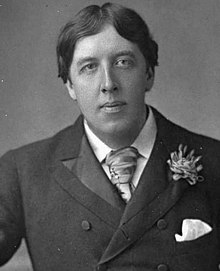
Wilde’s star as a writer continued to rise after this. Over the next several years, he published a number of short stories — most of which alluded to “Greek love” more openly than his works had before. In 1890, Wilde published The Picture of Dorian Gray — a novel that catapulted him to an even higher degree of fame. (Incidentally, Dorian Gray was likely inspired — at least in name, if nothing else — by Wilde’s next ex-lover, John Gray. Gray did his best to deny this rumor.) It was publicly trashed by critics, particularly for the hedonism depicted in the novel — and the rather obvious references to homosexuality. It was heavily edited, some of the more transparent homo eroticism taken out and six new chapters added, and re-released in 1891. It was in this year, Wilde was introduced to Lord Alfred Douglas (aka “Bosie” to his friends), a student at Oxford at the time but with a great interest in literature — and the two struck up a friendship. This friendship would ultimately change the trajectory of Wilde’s life — and impact the entire underground queer community of Europe.
….for the thrilling conclusion, click here.
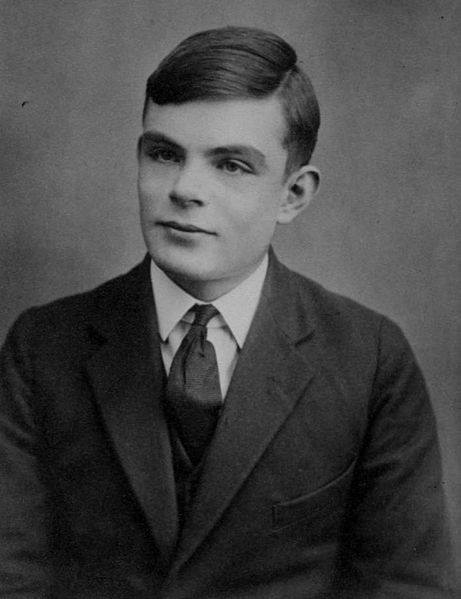 Alan Turing was born on June 23, 1912 in London. (He was one of a handful LGBT+ figures who were born on this day — the birthday is shared by
Alan Turing was born on June 23, 1912 in London. (He was one of a handful LGBT+ figures who were born on this day — the birthday is shared by